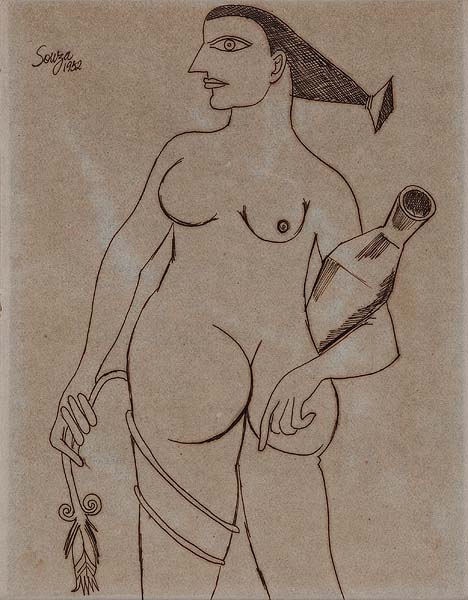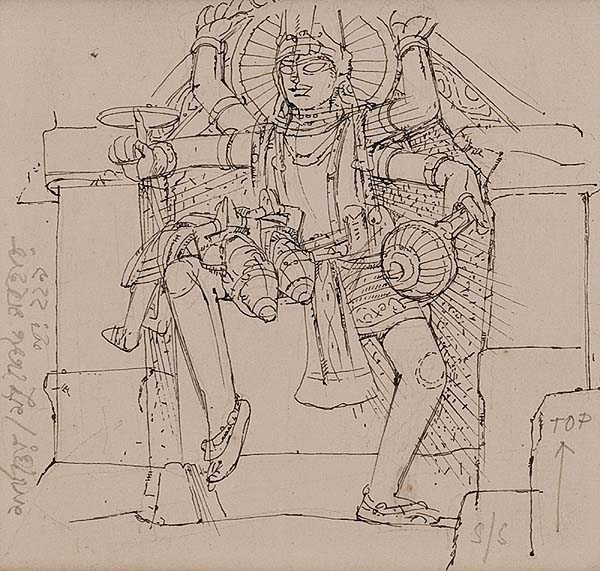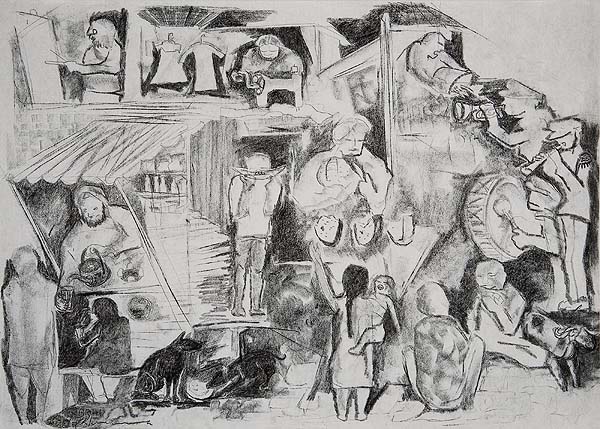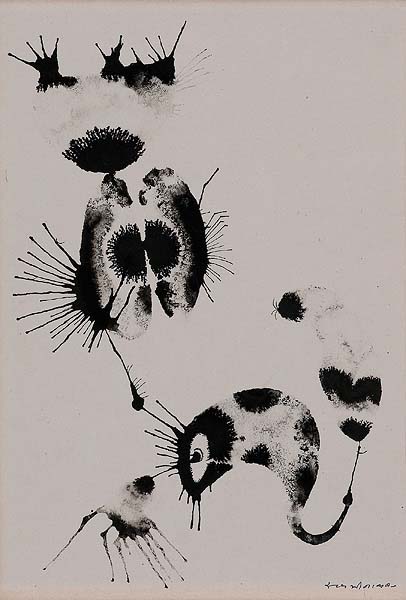
Francis Newton Souza
Untitled
1952
Ink on paper
10.5 x 8 in | 26.7 x 20.3 cm
Signed and dated in English (upper left)
Estimate
$3,000 – 4,000
Rs 1,32,000 – 1,76,000
Indian Contemporary Art – Husain, Gaitonde, Souza & more…
Are you a lover of contemporary Indian art who always thought collecting art was beyond your means? Did you think you’d have to mortgage your house – and sell your soul – to obtain an MF Husain? Were you always intimidated by the art auctions which seemed so elitist and such a closed club? Well here’s Anu Nanavati Chaddha, Director of Saffronart in New York, to show the path to newbie collectors and to answer all the questions you had about contemporary Indian art – but were afraid to ask.
I recently visited Saffronart which is in the prestigious Fuller building on Madison Avenue for a preview of an upcoming auction ’99 Modern Paperworks’ which will take place online on . The walls of the gallery were awash with the works of major Indian contemporary artists and modernists like M.F. Husain, Gaitonde, Akbar Padmasee, Souza and Swaminathan – names which go for six figures in the galleries and auction houses of the world. The figures caught my eye – for these striking works by these world-renowned names, the estimates were often $1000 to $2000 only. And then it struck me – these were paper works, not canvases. As Anu Nanavati Chaddha pointed out, these paperworks are often a great entry point for new collectors to get their feet wet in the art market and obtain oted names.
“Attracively estimated works offer young collectors the opportunity to acquire their first significant modern Indian artwork,” she says. “There are works by leading Indian artists Tyeb Mehta, V.S. Gaitonde, F.N. Souza, Nasreen Mohamedi, Arpita Singh, Jogen Chowdhury and more, all with competitive estimates. Several of these works have lower estimates in the $1000 range, which makes them very attractive to first time collectors who want to get the feel for acquiring an artwork at auction.”
Chaddha is a Specialist of Modern and Contemporary Indian Art and established and heads the New York office of Saffronart since 2004. As Vice President, International Markets she has led the expansion and consolidation of the auction in the USA and has been instrumental in developing Saffronart’s biannual jewelry sales since 2008. I thought she’d be a great person to guide new would-be collectors through the Byzantine world of contemporary Indian art with some tips and answers to questions about raising a paddle in the glorified world of art auctions.

Ganesh Pyne
Untitled
Ink on paper
3.5 x 3.5 in | 8.9 x 8.9 cm
Estimate
$1,500 – 2,000
Rs 66,000 – 88,000
Five tips for newbie collectors
1. Pick artists with established reputations
2. Trust your instincts and select work that aesthetically/visually appeals to you
3. Read critically as much as possible of the available literature on the artist. Each piece has a history and it is imperative to secure information about the artist, and the media in which they work for quality and significant works.
4. Visit as many exhibitions of artists of your interest and others. Attend exhibitions, both commercial and cultural, and talk, where possible with the exhibitors. Gallery Staff can be useful guides for art education. Visit and join your local art museums as also attend art conferences that speak on issues of collecting www.Indianartnews.com a blog on Modern and Contemporary art is an invaluable resource
5. Pick two or more works significant to an artist’s oeuvre (series etc.) to lay the foundations for a good collection
How does an online auction work?
The auction will take place on the Saffronart website starting Wednesday, July 20, 2011 8:00 pm (India Time); 10:30 am (US Eastern Time). Collectors first pre-register for the auction by following the link on the homepage. Once bidding access is granted, collectors may log on and place online bids by clicking on the “Bid Now” button next to each lot. For more information on the bidding process, read Saffronart’s How to Bid guide.
Does the winning bid generally fall within the estimated figures?
While each lot has a price range listed, these estimates are provided only as a guide for buyers. The winning bid may either be below, within or above the estimate depending on the demand for the particular lot.
What should a newbie collector look for in selecting an artwork?
There are a lot of factors to consider while selecting an artwork in addition to its appeal to the collector. These include, but are not limited to, the way in which the artist’s career has developed, the aesthetic quality of the work, the period and/or series that it belongs to, its relative rarity or significance, its provenance and its condition.
Canvases seem to appreciate in value – what about paper works?
The pricing for works on paper is subject to the same market forces as the pricing for canvases. Quality works with Solid provenance are sought after

Krishen Khanna
Garhi
Charcoal on paper
13.5 x 19 in | 34.3 x 48.3 cm
Signed in English (lower left)
Estimate
$2,000 – 3,000
Rs 88,000 – 1,32,000
What are the best ways to conserve works on paper?
Paper works are vulnerable art objects, and need protection. The best way to conserve paper works is to frame them protecting it from dirt, dust and handling, while maintaining a controlled setting essential for the life of the piece. The mat provides a rigid support for the work of art, to prevent bending and folding and other damage that might occur. All materials used in the matting and framing should be archival. This basically means that matting boards are acid-free and made of all-rag fiber. Any reputable framing store will use archival materials. Works on paper must also be hung or stored in a cool, dry location, away from direct sunlight.
Where can would-be collectors learn more about art?
Museums, galleries and publications are all important for getting knowledge of art. Recently museums like Rubin Museum of Art, Museum of Fine Art in Boston and San Jose Museum in California have all shown the works of modern art work and contemporary Indian art.
At Saffronart, we use our website to providing a learning, viewing and buying experience. It provides, and offers convenient access to an extensive range of art for sale, along with detailed information on artists and art-related events and exhibitions. It also offers collectors personalized services to help create and develop an art collection over time. With a dedicated team of art professionals and a personal relationship manager for each individual or institutional collector, we provide comprehensive set of options and information to guide decisions on widening and deepening a collection.
How does one go about re-selling the artwork?
An artwork may be resold through a dealer, gallery or auction house. Saffronart provides appraisal services for the evaluation of artwork or an art collection to assist in determining current market value, and advises collectors on the best avenue of sale for the works they are considering for sale.
Which are your personal favorites in the upcoming auction, and your parting words of wisdom for new collectors.
There are many works in this sale, FN Souza, VS Gaitonde and Ganesh Pyne that are good buys.
This is a sale where new collectors can pick up a couple of works to start building a collection around. The estimates are very affordable and the quality of these works are exceptional
The two portraits by Akbar Padamsee Lot 16 & 47 are very rare as precursors for his series on figures.
There are some beauties in terms of technical skill – Lot 56 by Jogen Chodhury and detail – Lot 28 by K Laxma Goud.
In Lot 78 Garhi by Krishen Khanna, the significant elements of everyman that the artists repeatedly paints are incorporated, like the Bandwalas, the street scenes ( or Dhaba’s) the fruit sellers. In Lot 36 by FN Souza, the artist’s mastery over color and bold lines are apparent.

Jagdish Swaminathan
Untitled
Ink on paper
11 x 7.5 in | 27.9 x 19.0 cm
Signed in Devnagari (lower right)
Estimate
$3,000 – 4,000
Rs 1,32,000 – 1,76,000
Saffronart’s Tips on Looking After Your Artwork
Apart from natural calamities, intrinsic composition and insects, we humans rank highest in causing damage to an artwork. Surprised? Here is a brief look at some of the most likely damage
Indian Contemporary Art: Handling
Breakages or tears in the surface, loose or missing parts of the surface or medium, impact related damage, smudges to the medium.
Stains from contact (including fingerprints), food materials, smoke, cosmetics and other domestic chemicals like cleaners.
Presence of conditions that foster pests, or other environmental damage like contact with infested objects, poor storage, and exposure to excessive heat, humidity and direct light.
Moving
Whether the move is from one wall to another, or between locations:
Always consider the best way to remove the artwork and get additional help if required especially for larger pieces
Prepare the final destination of the move before hand
Always wear gloves
Make sure that there is enough space to move around
Use equipment with care, even seemingly harmless pens
Ensure that the artwork is properly packed, use quality material
Use corners to avoid frames from getting damaged
It is not advisable to leave works packed for too long
Lighting
The most basic rule with lighting an artwork is to avoid displaying the artwork in direct sunlight. Exposure to strong artificial light for extended period is also not advisable as fixed lights over an artwork may cause localized heating. Lights should be placed a minimum of 10 feet from the artwork to avoid this. The recommended lighting for paintings is 200 lux. Light levels can be measured using a camera’s light meter.
Cleaning
Some simple cleaning tips that can be followed at home
Like other objects, artworks will collect dust and dirt over time. Dust can be removed using a very soft brush. Avoid feather and sheep skin dusters as their fibers attach to the surface. Check for flaking paint before dusting, and do not attempt to dust if the surface appears damaged ot unstable. It is also important to clean the verso of the artwork in a similar manner; however the artwork should be removed from display and laid flat on a clean surface to do this. Do not attempt any repair yourself. This is a process that should only be carried out by fully qualified, professional conservators.
(Source: Saffronart.com )
Related Article:

3 Comments
Very good information… thanks
Thanks, Vilas. Learned a few things myself from the interview!
Nice and brief informative article.
Like it.